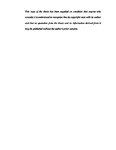ON THE ROLE OF AERATION, ELASTICITY AND WAVE-STRUCTURE INTERACTION ON HYDRODYNAMIC IMPACT LOADING
| dc.contributor.supervisor | Greaves, Deborah | |
| dc.contributor.author | Mai, Trí Cao | |
| dc.contributor.other | Faculty of Science and Engineering | en_US |
| dc.date.accessioned | 2017-08-31T15:15:42Z | |
| dc.date.available | 2017-08-31T15:15:42Z | |
| dc.date.issued | 2017 | |
| dc.date.issued | 2017 | |
| dc.identifier | 10539241 | en_US |
| dc.identifier.uri | http://hdl.handle.net/10026.1/9884 | |
| dc.description.abstract |
Local and global loadings, which may cause the local damage and/or global failure and collapse of offshore structures and ships, are experimentally investigated in this study. The big research question is how the aeration of water and the elasticity of the structural section affect loading during severe environmental conditions. A further question is how the scattered waves from ships and offshore structures, the mooring line force and the structural response, which are known to affect local load and contribute to global load, will be affected by wave-structure interaction of a ship or offshore structure under non-breaking wave conditions. Three different experiments were undertaken in this study to try to answer these questions: (i) slamming impacts of a square flat rigid/elastic plate, which represents a plate section of the bottom or bow of ship structure, onto pure and aerated water surface with zero degree deadrise angle; (ii) wave impacts on a truncated vertical rigid/elastic wall in pure and aerated water, where the wall represents a plate section of a hull; and (iii) wave-structure interactions of different FPSO-shaped models, where the models were fixed or taut moored. The experiments were carried out at Plymouth University’s COAST Laboratory. Spatial impact pressure distributions on the square plate have been characterised under different impact velocities. It was found that the impact pressures and force in pure water were proportional to the square of impact velocity. There was a significant reduction in both the maximum impact pressure and force for slamming in aerated water compared to that in pure water. An exponential relationship of the maximum force and the void fraction is proposed and its coefficients are found from drop test in this study. There was also a significant reduction in the first phase of the pressure and force impulse for slamming into aerated water compared with pure water. On the truncated wall, aeration also significantly reduced peak wave loads (both pressure and force) but impulses were not reduced by very much. For the case considered here, elasticity of the impact plate has a significant effect on the impact loads, though only at high impact velocities; here the impact loads were considerably reduced with increasing elasticity. Wave loading on the truncated wall was found to reduce with increasing elasticity of the wall for all investigated breaking wave types: high aeration, flip-through and slightly breaking wave impacts. In particular, impact pressure decreases with increasing elasticity of the wall under flip-through wave impact. As elasticity increases, the impulse of the first positive phase of pressure and force decreases significantly. This significant effect of hydroelasticity is also found for the total force impulse on the vertical wall under wave impacts. Scattered waves were generated from the interaction of focused wave groups with an FPSO model. The results show that close to the bow of the FPSO model, the highest amplitude scattered waves are observed with the most compact model, and the third- and fourth-harmonics are significantly larger than the incident bound harmonic components. At the locations close to the stern, the linear harmonic was found to increase as the model length was decreased, although the nonlinear harmonics were similar for all three tested lengths, and the second- and third-harmonics were strongest with the medium length model. The nonlinear scattered waves increased with increasing wave steepness and a second pulse was evident in the higher-order scattered wave fields for the fixed and free floating models. In addition, the higher harmonics of the mooring line force, and the heave and pitch motions all increased with increasing wave steepness. Incident wave angles of 0 (head-on), 10 and 20 degrees were experimentally investigated in this study. As the incident wave angle between the waves and the long axis of the vessel was increased from 0 to 20 degrees, the third- and fourth-harmonic scattered waves reduced on the upstream side. These third- and fourth-harmonic diffracted waves are important in assessing wave run-up and loading for offshore structure design and ringing-type structural response in fixed and taut moored structures. The second-, third- and fourth-harmonics of the mooring line force, and the heave and pitch motions decreased as the incident wave angle increased from 0 to 20 degrees. | en_US |
| dc.language.iso | en | |
| dc.publisher | University of Plymouth | |
| dc.subject | Wave impact | |
| dc.subject | Aeration | |
| dc.subject | Hydroelasticity | |
| dc.subject | FPSO | |
| dc.subject | Wave-structure interaction | |
| dc.subject | Slamming | en_US |
| dc.subject.classification | PhD | en_US |
| dc.title | ON THE ROLE OF AERATION, ELASTICITY AND WAVE-STRUCTURE INTERACTION ON HYDRODYNAMIC IMPACT LOADING | en_US |
| dc.type | Thesis | |
| plymouth.version | publishable | en_US |
| dc.identifier.doi | http://dx.doi.org/10.24382/579 | |
| dc.rights.embargoperiod | No embargo | en_US |
| dc.type.qualification | Doctorate | en_US |
| rioxxterms.version | NA | |
| plymouth.orcid.id | http://orcid.org/0000-0002-1366-0046 | en_US |
Files in this item
This item appears in the following Collection(s)
-
01 Research Theses Main Collection
Research Theses Main


